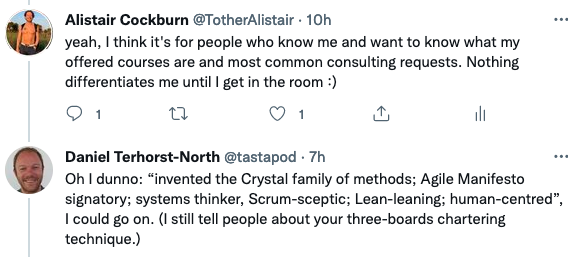Dr. Alistair Cockburn

Dr. Cockburn is the world expert on agile methodologies, use cases, and hexagonal architecture. He was voted in 2007 one of the "All-Time Top 150 i-Technology Heroes," and then in 2020 as one of the "42 Greatest Software Professionals of All Times."
In addition to agile methodologies, use cases and hexagonal architecture, he is also internationally recogized for his expertise in strategies in project management.

He is the author of three books that changed the industry:
- Writing Effective Use Cases, written in 2000 and still relevant, has sold hundreds of thousands of copies and serves as the foundation text in both universities and industry.
- Agile Software Development: The Cooperative Game, written in 2001, is still listed as the most essential book for people to read as they start on their journey with agile development.
-
Hexagonal Architecture Explained: How the Ports & Adapters architecture simplifies your life, and how to implement it (Updated 1st Ed), published in 2025, is the reference bible on this foundational pattern used by Amazon, Netflix and other mega-companies.
Some of Dr. Cockburn's Notable Memes
-
This photo, the "wild hair" picture, is the most widely recognized bio picture, serving as his LinkedIn profile and photo for as many conference lectures as will permit :).

If you have heard these terms, they came from Dr. Cockburn:
-
(1995) Kite / sea / fish-level goals: From the article "Structuring use cases with goals."
-
(1996) Walking Skeleton: A thinly connected functioning architecture.
- (1998) Blitz Planning: A collaborative project planning and estimation technique in which all team members or roles are present and they brainstorm and co-create a map and timeline for the project.
- (1998) The Cockburn Scale: A 2D chart showing the various sorts of projects you might find yourself on, to highlight that different strategies and methodologies are needed at different time.
- (1998) Software development as a cooperative game “Software development is a (series of) cooperative game(s), in which people use markers and props to inform, remind and inspire themselves and each other in getting to the next move in the game."
- (1998) "A user story is a promise for a conversation": A phrase he coined when visiting the first Extreme Programming project in Detroit. Since expanded by Ron Jeffries to Card, Conversation, Confirmation.
- (2000) Information Radiators: One of Dr. Cockburn's most used phrases, coined during a visit to Thoughtworks in Chicago in 2000. There have been contests for the best information radiators.
-
(2001) Osmotic communication: People working within earshot so they learn about things through background hearing.
- (2005) Hexagonal Architecture: is a software architecture used to protect domain logic from external technologies and simplify testing.
-
(2006) Oath of non-allegiance: "I promise not to exclude from consideration any idea based on its source, but to consider ideas across schools and heritages in order to find the ones that best suit the current situation."
-
(2006) The "Cone of Silence" project management strategy: Isolate a person or team from neighboring teams and all distractions so they can get their work done.
-
(2010) Elephant Carpaccio: The exercise in which a problem is sliced into nano-slices to be developed several slices per 8-minute interval.
-
(2015) The Heart of Agile: Collaborate-Deliver-Reflect-Improve, the short-form expression of what agile is really about.
Some of this other frequently quoted phrases include:
-
"Trim the tail" (part of his incremental development talks). (2008)
-
"Agile is an attitude, not a technique with boundaries. An attitude has no boundaries, so we wouldn't ask 'can I use agile here', but rather 'how would I act in the agile way here?' or 'how agile can we be, here?'"
-
"I finally concluded that there is something there, in front of us all the time, which we are not seeing: people. People’s characteristics are a first-order success driver." (1999) From Characterizing people as non-linear, first-order components in software development.
-
Collaboration Cards: (2007) From his article, Collaboration: The dance of contribution.
-
"If it’s your decision, it’s design; if not, it’s a requirement (to you)." (from his use case classes). Long form: "A requirement is a person's relationship to a decision: if you can't change it, it's a requirement TO YOU; if you can, it's part of design TO YOU."
The internet offered this longer list of memes and quotes from Alistair: Which ones have you heard of?
-
A user story is a promise for a conversation.
-
Agile is an attitude, not a technique with boundaries. An attitude has no boundaries, so we wouldn't ask 'can I use agile here', but rather 'how would I act in the agile way here?' or 'how agile can we be, here?'
-
Agile means early delivery of business value. And reduced bureaucracy.
- Blitz Planning.
- Cheating legally.
- Collaborate to deliver, reflect to improve.
-
Collaboration Cards.
-
Cone of Silence.
-
Crystal is the “sloppiest methodology that can possibly work.”
-
Do not to exclude from consideration any idea only based on its source.Elephant Carpaccio
-
Elephant Carpaccio.
-
Hexagonal Architecture.Information Radiators.
-
If it’s your decision, it’s design; if not, it’s a requirement (to you).
-
If you can describe a process in sufficient detail to be specifically useful, it is too detailed to be followed, and if you make something simple enough to be followed, it doesn't contain enough detail to be specifically useful.
-
Kite / sea / fish-level goals.Oath of non-allegiance
-
Obsidian tools FTW.
-
Osmotic Communication.
-
People’s characteristics are a first-order success driver.
- Software development as a cooperative game of invention and communication.
- Shu-Ha-Ri applied to software development skiils (it comes from Aikido)
-
The Cockburn Scale.
-
The most effective form of communication is two people talking at a whiteboard.
- The speed of the project is the speed at which ideas move between minds.
- There are only three moves: invent, communicate, decide.
-
Trim the tail.
-
Walking skeleton.
-
Your best idea will be misquoted and misused, or ignored, and you don't get to choose which.
-
see https://motleybytes.com/w/Alistair_Cockburn_quotes for more quotes.
A Brief History
In 1993, after two years of interviewing teams around the world on "What makes a successful project?", he wrote for the IBM Consulting Group an early version of what we now call an agile methodology. He and IBM used that methodology successfully in 1994 on a 18-month, $15M, fixed-price, fixed scope Smalltalk project, with Alistair as lead consultant and technical coordinator.
In 1998 he helped the Central Bank of Norway successfully deliver a difficult mainframe project that merged all the bank-to-bank transactions in the country of Norway. He also designed the Crystal family of methodologies while at the Central Bank of Norway.
In 2001, he organized the historic meeting in Snowbird, Utah, in which he and 16 other people from around the world wrote the Agile Manifesto. That manifesto revolutionized the field of software development, and then product management and eventually project management and organizational development in general. The "agile" approach - once considered radical - is now recommended in all industries from startups to government defense contracts, and even to government departments themselves, and social impact projects.
He published books in 1997 (Surviving Object-Oriented Projects), 2000 (Writing Effective Use Cases), 2001 (Agile Software Development), 2003 (his PhD dissertation, "People and Methodologies in Software Development), 2004 (Patterns for Effective Use Cases), 2005 (Crystal Clear), 2006 (Agile Software Development: The Cooperative Game, 2nd ed.).
In 2015, Dr. Cockburn synthesized his advice to just four words: Collaborate, Deliver, Reflect, Improve - what he calls the Heart of Agile. These four words make any initiative more effective and more enjoyable to work on. Dr. Cockburn and his associates at the Heart of Agile Academy apply all the techniques they learn to different project situations.
With his background, Dr. Cockburn is one of the few people in the world who can authoritatively relate agile development to the need for executive control, balancing fiduciary responsibility with the need to stay responsive to a changing world. He stays grounded by consulting, teaching and working with project practitioners in all active roles, particularly project managers, product owners, scrum masters, coaches and programmers. This real-problem contact keeps him in tune with the changing work situations.
Please write to me about how else I might be able to help:


